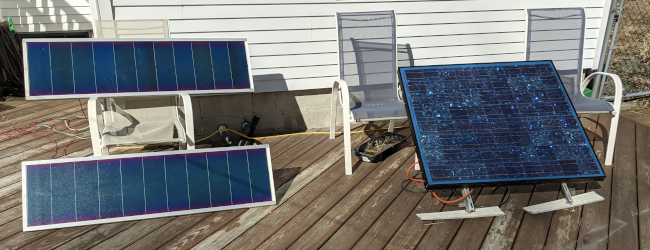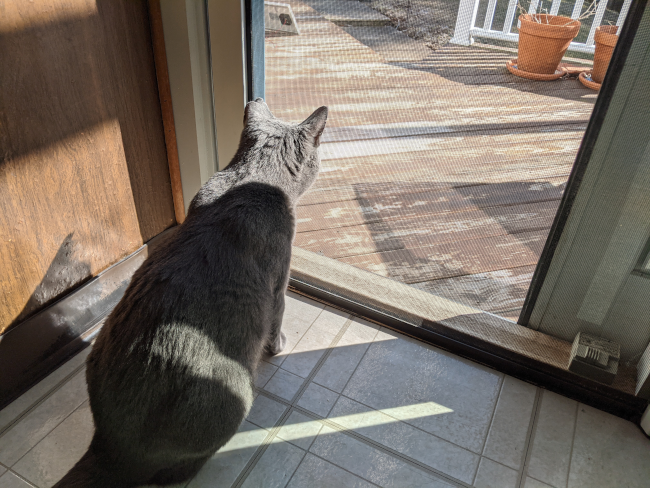Today is the first day of spring here in the Northern Hemisphere, and it’s quite sunny out. I have about 164 watts of solar between three panels, just sitting on my deck. They are charging an old (~12 years) 49 Ah AGM battery in my garage, which still holds something of a charge but not quite what it used to.

Where I live, electricity is pretty cheap and reliable (municipal coop), and it’s bought from hydro and nuclear generation. This system has evolved over time, and it’s mostly a hobby. However, I wonder about making better use of the power I get from it.
The obvious answer is to try to grid tie these (or other) panels. That would require an appropriate inverter, plus professional installation, approval, etc. It makes sense in a lot of ways, since that way the panels get to run my entire house by virtue of tying into the main breaker panel. Not to mention that these are mismatched, and I’d need to find an inverter that could handle a conglomeration of 12 volt panels (the big one can actually be rewired for 24 volts). I’d rather not use one of the PowerJack inverters, although admittedly I haven’t looked at other grid tie inverters besides from seeing those on Youtube here and there.
I’d like to keep this system off-grid – like I said, my power is cheap, and I’m not sure a big grid-tied array would make sense just from that standpoint. But honestly, I love messing with a small independent system, and it has a few advantages:
- Obviously, it’s a source of backup power, and it’s pretty convenient for lighting and phone charging. Power outages aren’t frequent enough that I’m thinking about getting a generator to keep the fridge going, but just having a little bit of reserve is nice.
- It’s a source of DC power. I have an amateur radio license, and most ham gear runs from 12 VDC. This is a little tricky since the system is in the garage, but I will get to this.
- It’s a way to experiment with… Off-grid systems! Other projects I’ve had kicking around in the back of my head for years directly apply here, and so it makes sense to have an actual application for them. Examples include various DC-DC converter ideas, as well as a DC-AC inverter.
I’ve been thinking about how to upgrade this system. Like I said the battery is old, but it works well enough as a buffer that it’s not completely useless. The charge controller I have is a Morningstar ProStar 30, which is PWM. I could enter the 21st century and get an MPPT controller, and squeeze out an extra amp or so into the battery. I did get a 300 watt true sine wave inverter (the modified sine wave one I had was the victim of a flood), which is nice, but this will eventually be replaced by a homebrew solution.
Of course, this is a lead acid battery, and I’ve also been looking at LiFePO4 as well. This technology is intriguing, given that while it’s more expensive up front it lasts longer in terms of deep cycles. (Lead acid, even deep cycle, lasts longer with shallower cycles.) That said, while I haven’t done an in-depth analysis, it seems that if you’re going to lead a battery float most of the time like in a UPS, lead acid might still be the way to go cost-wise. This of course depends on the quality of the charger, for instance I wouldn’t trust a cheap UPS unit to be a shining example of lead acid charging.
All this aside, something I’ve thought of quite a bit is the idea of siphoning excess power off to do something useful. If I’m not going to grid tie, then I need to get a little creative. The idea is to minimize actual cycling, so ideally the load here would be something that could be served during the day when there’s sun.
DC Distribution
I should take a moment to note that wiring your home for low voltage DC isn’t always the greatest idea. It sounds great when you think of devices running from 12 or 5 VDC anyways, by means of a wall cube or a brick, and that you could avoid using an inverter to do an extra conversion step. (Kind of two steps, when you realize that with a low voltage system, the inverter needs to step battery voltage up to a high enough DC voltage to make the 120 VRMS sine wave, or whatever it would be in your area.)
Contrary to what some think, AC doesn’t inherently travel over long distances better. In fact, it incurs reactive losses, since by nature the voltage and current are changing. But sending a lot of power over long distances does require high voltage, since that means less current for a given amount of power. AC makes this easy by means of a transformer, basically wire wrapped around an iron core. Pretty simple, for certain values of simple.
Thanks to modern power electronics, you can of course step DC up and down too. In fact, a lot of household devices do this, and rectify DC and use a switching power supply to get a lower voltage. It will probably still end up using a transformer and pulse the DC into it, but you can do that at a high frequency which means that the magnetics can be smaller. A transformer for, say, 20 kHz can be smaller than one for 60 Hz. However, this all requires more supporting circuitry – power transistors to do the switching, capacitors, inductors, and transformers, some kind of controller, etc. High voltage DC is used for transmission, since you can avoid reactive losses, but having to address some of this means that it’s used where the expenses of the transmission line would outweigh the cost of the added rectifier/inverter station.
There’s another issue as well. The reactive losses I mentioned essentially resist changes to the flow of current, which obviously is an impediment to AC. But with DC, it’s a different kind of impediment. While they will resist the current ramping up, they can also resist ramping it down. If you have a fault of some sort, the inductance in a wire will try to keep the current flowing. It does this by jacking the voltage up.
This is something you exploit in, say, a buck or boost converter, where you switch a power source into an inductor. The inductor raises or lowers the voltage using the energy it stores in its magnetic field. However, while an inductor is a part you might design into a circuit, a length of wire is also an inductor. If you want to stop current from flowing in a DC circuit, you need to respect that.
Practically, this means that you need DC-rated switches, connectors, and overcurrent protection. This exists, but it’s not as common as what you can get at say Home Depot. (Actually, Square D QO breakers do have a DC rating, I believe. Double check this.) And if you’re using, say, 12 or 24 VDC, you need bigger wire – at 12 volts, for instance, a 100 watt load is about 8.3 A. This means you need to make sure you have solid connections, as pushing high current through a bad connection can cause it to heat up. And then unless you use huge wire, you have to deal with voltage drop.
Of course, high(er) voltage DC is one possibility. Off-grid solar systems typically go up to 48 VDC nominal, which is easier to deal with. You could keep throwing 12 volt batteries in series and end up with 120 VDC, but that kind of compounds the problems I mentioned earlier – now you have a high voltage which can push even more current through a given resistance, so you have that plus the effect of the wiring inductance in the event of a fault. 120 VDC is used in some applications, and it’s not as if it’s impossible to work with, but I wouldn’t just plug my home wiring into it unmodified.
Where to Use DC
Maybe you’re willing to take on the engineering project of wiring a house for DC, low or high voltage, and spend the money on huge wire and appropriately-rated devices. Most likely, though, using standard off-the-shelf parts and readily-available expertise for AC wiring is the way to go. That said, it’s worth considering using DC in certain cases, in my opinion.
- A tiny system, maybe a portable one, where you want to run a couple lights and charge your phone. This might be something that fits into a backpack. Maybe it’s just a battery and a cable with a plug of some sort.
- Something like a small cabin, with a short wire run to the loads. Maybe the battery is close to say a water pump, a light fixture, etc.
- A system which isn’t too far from loads, but most everything just runs on DC anyways. (I’ll get into this one more soon.) An example is a ham radio setup, although this could be debatable. It might make sense to simply use an inverter and have that drive a benchtop supply to run your shack.
- A DC light fixture for the room where the rest of your system is. That way if your inverter goes down, you can troubleshoot it.
The third point is something I’ve thought about – my system is in my garage, but I have ham radio gear in the second floor of my house. Additionally, I have networking gear in the basement, much of which could run off of 12 VDC. So while I wouldn’t want to rewire my house to swap too many circuits to 12 volts, how could I bring some power from place to place, and selectively siphon off excess from the solar?
Low-Power DC Transmission
So now I’m going to go against my own advice, and try to move DC to a different area of my house. 🙂 To do this, I’ve been kicking around a DC-DC converter, really a buck converter, that would work bidirectionally. That’s for flexibility, so that I can use the same one in two places.
So it might go like this: Step 12 VDC from my battery in the garage to say 36 VDC, and then run that into my basement. Use another converter in reverse to bring it back down to 12 VDC. That means a three-fold reduction in current. It also means needing to use proper fusing, of course. But it would also be non-permanent and easily undoable.
Actually, the main reason for this is to design and build the converter, to prop my own skills. There’s designing it, laying it out on a PCB, and doing the controls for it (microcontroller project!). And I’m interested in the idea of controlling this to, for instance, run in parallel with a standard power brick supplying an industrial PC I’m using as a server, and basically take load off the grid. So it’s kind of like a grid-tie inverter, without the grid-tie.
Obviously, this may not be the most practical thing for most people, I just happen to be the type of weirdo who thinks it might be fun. I will post more as I explore it.
Cat
George is an indoor creature, but he used to be a stray. Now that it’s sunny he has spring fever, and he’s tried to escape once or twice. I won’t let him, and he usually does okay staying inside, but I do pick him up now and then and walk him around outside. I also leave the door open to the screen so he can sit and listen to the birds and sniff.
